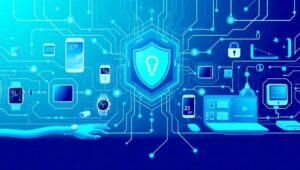Securing Personal Gadgets in an Interconnected World: Navigating the Challenges of 2025
The year is 2025. Our lives are more intertwined with technology than ever before. From smart homes to wearable health monitors, personal gadgets offer unprecedented convenience and connectivity. However, this hyper-connectivity also introduces significant security challenges. This article explores the evolving landscape of personal gadget security and provides actionable strategies to protect your digital life.
The Expanding Threat Landscape
The increasing sophistication of cyber threats poses a significant risk to personal gadgets. Consider these factors:
- IoT Device Vulnerabilities: Many Internet of Things (IoT) devices are designed with minimal security protocols, making them easy targets for hackers. A compromised smart fridge, for example, could be a gateway to your home network.
- Data Privacy Concerns: Wearable devices collect vast amounts of personal data, including health metrics and location information. Securing this data from unauthorized access is critical.
- Phishing and Social Engineering: Cybercriminals are becoming more adept at using phishing tactics and social engineering to trick users into divulging sensitive information.
- Ransomware Attacks: Ransomware attacks are no longer limited to computers; they can target smart devices, locking users out of their own systems until a ransom is paid.
Strategies for Securing Your Gadgets
To mitigate these risks, consider implementing the following security measures:
- Strong Passwords and Multi-Factor Authentication (MFA): Use strong, unique passwords for each device and enable MFA whenever possible. Password managers can help you generate and store complex passwords securely.
- Regular Software Updates: Keep your devices’ software and firmware up to date. Software updates often include security patches that address known vulnerabilities.
- Network Segmentation: Segment your home network to isolate sensitive devices. This can prevent a compromised device from affecting the rest of your network. Create a separate network for IoT devices.
- Privacy Settings Configuration: Review and adjust the privacy settings on each device to limit data collection and sharing. Disable features you don’t need.
- Secure Wi-Fi: Use a strong password for your Wi-Fi network and enable encryption (WPA3 is recommended). Consider using a virtual private network (VPN) when connecting to public Wi-Fi.
- Endpoint Security Software: Install reputable antivirus and anti-malware software on your computers and mobile devices. These programs can detect and remove malicious software.
- Physical Security: Secure your devices physically to prevent theft or tampering. Use device tracking features to locate lost or stolen devices.
- Awareness and Education: Stay informed about the latest security threats and best practices. Educate yourself and your family members about phishing scams and other cyber threats.
The Future of Gadget Security
Looking ahead, several trends will shape the future of gadget security:
- AI-Powered Security: Artificial intelligence (AI) will play an increasing role in detecting and responding to cyber threats. AI-powered security systems can analyze device behavior and identify anomalies that may indicate a compromise.
- Blockchain Technology: Blockchain can be used to secure IoT devices and protect data integrity. It can provide a tamper-proof record of device activity and prevent unauthorized modifications.
- Hardware-Based Security: Hardware-based security features, such as secure enclaves and trusted platform modules (TPMs), can provide an additional layer of protection against cyber attacks.
Conclusion
Securing personal gadgets in an interconnected world requires a multi-faceted approach. By implementing strong security measures, staying informed about the latest threats, and embracing emerging security technologies, you can protect your digital life and enjoy the benefits of a connected world with greater confidence. As we move further into 2025, proactive security measures are essential for navigating the evolving threat landscape.




